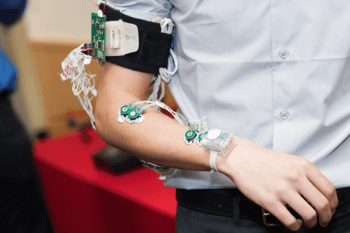New Technology Could Enable Smart Devices To Recognize, Interpret Sign Language

A smart device that translates sign language while being worn on the wrist could bridge the communications gap between the deaf and those who don’t know sign language, says a Texas A&M University biomedical engineering researcher who is developing the technology.
The wearable technology combines motion sensors and the measurement of electrical activity generated by muscles to interpret hand gestures, says Roozbeh Jafari, associate professor in the university’s Department of Biomedical Engineering and researcher at the Center for Remote Health Technologies and Systems.
Although the device is still in its prototype stage, it can already recognize 40 American Sign Language words with nearly 96 percent accuracy, notes Jafari who presented his research at the Institute of Electrical and Electronics Engineers (IEEE) 12th Annual Body Sensor Networks Conference this past June. The technology was among the top award winners in the Texas Instruments Innovation Challenge this past summer.
The technology, developed in collaboration with Texas Instruments, represents a growing interest in the development of high-tech sign language recognition systems (SLRs) but unlike other recent initiatives, Jafari’s system foregoes the use of a camera to capture gestures. Video-based recognition, he says, can suffer performance issues in poor lighting conditions, and the videos or images captured may be considered invasive to the user’s privacy. What’s more, because these systems require a user to gesture in front of a camera, they have limited wearability – and wearability, for Jafari, is key.
“Wearables provide a very interesting opportunity in the sense of their tight coupling with the human body,” Jafari says. “Because they are attached to our body, they know quite a bit about us throughout the day, and they can provide us with valuable feedback at the right times. With this in mind, we wanted to develop a technology in the form factor of a watch.”
Continue reading on Engineering Today.
This article by Ryan Garcia originally appeared in Engineering Today.





